South London
London south of the Thames has always been poorer and more deprived than its northern counterpart and has for generations drawn men called to preach the good news to the poor. Most of those who came recognised the need to feed bodies as well as save souls, and were active in a wide range of philanthropic ventures. Despite the legacy of bombs and bulldozers and the spread of low-rise housing estates, there is still evidence of the life and work of many zealous and dedicated Christians.
SOUTHWARK

Park Street, Southwark
When Charles Haddon Spurgeon (1834-1892) was invited to preach for a short spell at New Park Street Chapel in 1853, he was still a teenager and barely known outside some Christian circles. Within weeks, all that had changed. Fervent and eloquent, crowds flocked to his services and he was offered the pastorate. With every available seat filled, the seating capacity was increased to 1,800, but by 1859 a new church was needed and the Metropolitan Tabernacle was built at the Elephant and Castle, not far away. New Park Street Chapel was eventually demolished.
The chapel stood in Park Street, just behind the present Tate Modern Gallery at Bankside. Street names like Bear Gardens and Rose Alley bear witness to the entertainments of Elizabethan times. Shakespeare's Rose and Globe theatres were located here and the reconstructed Globe Theatre is close by. Also here is Zoar Street, named after the chapel where John Bunyan once preached. The chapel has gone but its pulpit is preserved in the John Bunyan Museum in Bedford.
WALWORTH
Several chapels and buildings in the area bear witness to the continued fruit of Spurgeon's ministry. They were all founded as extensions of the work of New Park Street and the Metropolitan Tabernacle. These include Haddon Hall Baptist Church in Tower Bridge Road; the Surrey Square Mission, off the Old Kent Road, used today as a Sunday School; East Street Mission (now the East Street Baptist Church) on the corner of East Street and Portland Street; and the Surrey Gardens Memorial Hall in Penrose Street. The last of these was built to commemorate Spurgeon's preaching in the Surrey Gardens Music Hall, which stood nearby. This was used on occasions to accommodate his vast congregations, despite the objections of some church members to the use of a secular building.
LAMBETH

Metropolitan Tabernacle
With Spurgeon's congregations growing ever larger, the Metropolitan Tabernacle was built in 1859 at the Elephant and Castle. It could seat over 4,000, but frequently 6,000 crowded in, many happy to stand. The building burned down in 1898, when Spurgeon's son was pastor, and was again severely damaged in World War II. On each occasion it was rebuilt, retaining the original portico with its six classical columns. The ministry continues today, with the impressive frontage of the church looking out onto the busy road and multi-coloured shopping centre.
At the junction of Westminster Bridge Road and Kennington Road is Christ Church and Upton Chapel, now serving a new congregation. As the foundation stone tells us, it was built in 1876 to replace the Surrey Chapel, which stood nearby (not to be confused with Surrey Gardens Music Hall). The Surrey Chapel was built for the ministry of Rowland Hill (1744-1833), a robust Calvinist and outstanding preacher. It opened in 1783 and eventually closed in 1881. The chapel maintained Sunday Schools for over 3,000 children and was noted for its interest in overseas missions. Hill was an early supporter of the London Missionary Society and on the same day in September 1816, two of its greatest pioneers were commissioned. These were Robert Moffat (1795-1883) and John Williams (1796-1839). Moffat opened up work in southern Africa, where he was later joined by his future son-in-law David Livingstone.
Known as the "Apostle of Polynesia", Williams went to the South Pacific, where he showed extraordinary zeal and ingenuity, on one occasion building a boat with few tools to escape from an island where he had become marooned. On 20th November 1839, he was killed by natives on the island of Erromanga, in revenge for previous ill- treatment by sailors in the area. His death stimulated a burst of enthusiasm for missionary work, and a succession of ships with the name John Williams were employed among the islands.
KENNINGTON
John Wesley and George Whitefield used Kennington Common, where prostitutes and pickpockets plied their trade, as one of their regular preaching arenas. London's teeming masses assembled here to witness hangings or engage in dubious forms of entertainment. When Whitefield preached, it has been soberly reckoned that the crowds were the largest ever reached by the unaided human voice.
Today Kennington Park seems peaceful enough, with rose beds and tennis courts, while visitors sunbathe or walk their dogs. In the eighteenth century it was the meeting place for those intent on vicious games or drunken brawls, where mobs assembled ready for acts of crime or violence. Those called to preach the Good News to sinners reckoned it was as good a place as any to start.
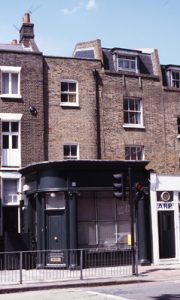
Filmer's former pawnshop
For 29th April 1739, George Whitefield wrote in his diary; .... at five went and preached at Kennington Common, about two miles from London, where no less than 30,000 people were supposed to be present. The wind being for me carried the voice to the extremest part of the audience. All stood attentive and joined in the Psalm and the Lord's Prayer most regularly..... I hope a good inroad has been made into the Devil's kingdom this day. Later that same year, John Wesley, having preached to ten thousand at Moorfields in the morning, went with his mother in the afternoon to Kennington where he preached to twenty thousand on the text Believe on the Lord Jesus, and thou shalt be saved. He then returned to preach to a full house at Lambeth and to a meeting of the Fetter Lane Society in the evening.
176 Kennington Park Road (SE11 4BU), immediately opposite the north end of the park, appears to be a shop front projecting onto the street from an older three-storey house behind, but is now a private home or office, with the door and windows framed by fluted columns. In 1849 this was Filmer's Pawnshop, where the young William Booth (1829-1912) worked when he first came to London from Nottingham. Booth's experience of the pawnbroker's trade gave him an insight into the plight of the poor and set him on his lifelong crusade against poverty.
CAMBERWELL

Catherine Booth statue
At Champion Park on Denmark Hill (SE5 8EN) is the International Headquarters of the Salvation Army and the William Booth College for training officers. This massive brick-built complex was opened in 1929. Outside are statues of William Booth, founder and first general, and his wife Catherine (1829-1890) "the army mother", each in a characteristic pose.
PECKHAM
The preacher and devotional writer Oswald Chambers (1874-1917) was born in Scotland but came to London at the age of fifteen. Converted after hearing Spurgeon preach at the Metropolitan Tabernacle, he attended Rye Lane Baptist Chapel, Peckham (SE15 5EX), and lived in Crofton Road. The chapel, built in 1863 in the typical nonconformist style, stands today facing the busy shopping street.
Chambers returned to Scotland to study art at Edinburgh. He later studied and worked with the Rev Duncan McGregor at a small theological college in Dunoon. From 1911 to 1915 he ran his own Bible Training College at 45 North Side, Clapham Common, part of an elegant six-storey Victorian terrace, but his work was interrupted by the First World War. He died of appendicitis in Egypt in 1917, while serving as a military chaplain with the YMCA. His widow faithfully edited and published his sermons and writings. His best known work My Utmost for his Highest is a collection of daily meditations for the year.
CLAPHAM
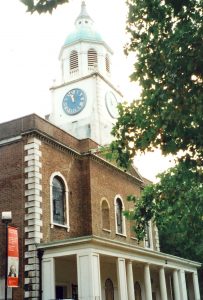
Holy Trinity Church, Clapham
In the late eighteenth century, Clapham was a village of a few thousand souls and the Common a wilderness of ponds and gorse bushes. When John Venn (1759-1813) arrived as rector of Holy Trinity Church in 1792, he drew to the area a number of wealthy and influential evangelical laymen, known to their contemporaries and to history as the Clapham Sect or Clapham Circle. Venn himself had been born in Clapham during the curacy of his father Henry Venn, later vicar of Huddersfield, a friend of John Wesley and George Whitefield.
The Georgian church with its classical entrance stands on the North Side of the Common. The members of the Sect are listed, and their achievements acclaimed, on a stone tablet on the south wall, still mostly legible. The pockmarks from wartime bombing are deliberately left unrepaired as a tribute to residents who endured the Blitz.
The best known was William Wilberforce (1759-1833), while the others included John Thornton (1720-1790), his son Henry Thornton (1760-1815), Charles Grant (1746-1823), John Shore (later Lord Teignmouth) (1751-1834), Zachary Macaulay (1768-1838), Granville Sharp (1735-1813), James Stephen (1789-1859) and John Venn's son, the younger Henry Venn (1796-1873).

Clapham Sect memorial
Inside, the church is impressively spacious, with galleries on three sides. The east window, installed in 1952, commemorates the work of the Clapham saints. While no names appear, the left window shows Sharp, John Thornton and Henry Venn, together with St Paul as the patron saint of missionaries, while the right depicts Wilberforce and John Venn with St Nicholas, patron saint of slaves. There are memorial tablets to the Thornton family on the south wall and to the Venn family on the north wall
The Thorntons were merchants of enormous wealth and corresponding generosity. Henry Thornton became MP for Southwark in 1783 and held the seat until his death, despite refusing to engage in bribery. He regularly gave away two-thirds of his income, supporting projects like Hannah More's schools for poor children in Somerset. Thornton's home was a small estate at Battersea Rise on the west side of the common. Wilberforce was his close friend and in 1792 took a house on the estate called Broomfield (later Broomwood House), where he lived for several years.
Charles Grant was a director of the East India Company and Lord Teignmouth a former Governor-General of India. They used their influence to lift the ban on missionary work in the subcontinent. Granville Sharp is best known for securing the legal ruling that a slave became free the moment he set foot in England.
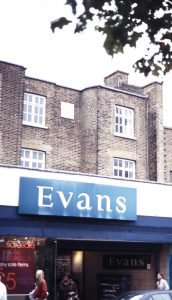
Zachary Macaulay's house
Zachary Macaulay had been sent to Jamaica at the age of sixteen as book-keeper to a sugar estate, but returned home disgusted at the treatment of the slave population. In 1793, he became Governor of Sierra Leone, a colony established by Wilberforce, Thornton and others for the resettlement of freed slaves in Africa. Here it was said that, at the age of twenty-five, he had to be governor, paymaster, judge and clerk, to preach sermons and celebrate marriages. When his health broke down, he returned to England and settled in Clapham. He edited the Christian Observer, the organ of the Sect, and was active in many of their projects. Macaulay's son was the well-known historian Thomas Babington Macaulay. James Stephen became Under Secretary of State for the Colonies and fathered a literary dynasty which continued for several generations.
The Clapham Sect is remembered mainly for its lengthy struggle against the Slave Trade. Success was achieved when the trade was abolished in 1807 and slavery itself in 1833. Slavery, however, was not the only cause to which these worthy gentlemen bent their ears. They set in place committees and groups which led to the foundation of the Church Missionary Society, the British and Foreign Bible Society and the Religious Tract Society. The supported the growing Sunday School movement and embarked on projects as diverse as savings banks for the poor and societies for promoting animal welfare.
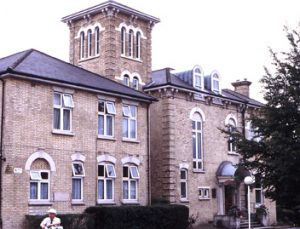
Spurgeon's house, Clapham
In today's Clapham, most of the houses of the Sect members have gone, but their names live on as streets and schools. Macaulay Road, Venn Street and the modern Henry Thornton School are all close to Holy Trinity church. One home that survives with a shop built on to the front is Macaulay's house, 5 The Pavement. A plaque high up on the wall can be seen from the entrance to Clapham Common tube station. Wilberforce's house, Broomfield, was demolished in 1904, but the site is marked by a plaque on the wall of 111 Broomwood Road, on the corner of Wroughton Road. The site of Lord Teignmouth's house, where the Sect usually held their meetings, was on the corner of Clapham Park Road, where St Mary's Roman Catholic Church and the Redemptorist College now stand.
Two generations later, another eminent evangelical found Clapham a congenial place to live. In 1857, Charles Haddon Spurgeon took up residence at 99 Nightingale Lane, a substantial building in yellow brick, then known as Helensburgh House. Today it is called Queen Elizabeth House (SW12 8LZ) and is divided into twelve flats for sheltered housing.
NORWOOD
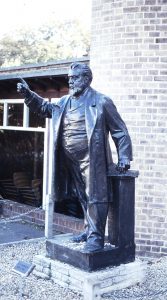
Spurgeon statue
Memories of Charles Spurgeon spill over from Clapham into Norwood. By today's standards, the house in Nightingale Lane would seem quite large enough for a minister and his family, but Spurgeon's status as the leading evangelical preacher of the day demanded a considerable staff and he moved to a palatial home called Westwood in what is now Spurgeon Road, Upper Norwood. Here he employed two secretaries, a butler, cook, maids, gardeners and a coachman. The elevated position of Norwood and its greater distance from the fogs of London helped to alleviate Spurgeons's chest problems. The site is now occupied by a girls' school.
Not far away, in South Norwood Hill, is Spurgeon's College, which continues to train men and women for the Baptist ministry. There is a statue of the preacher at the front and the college has a heritage room above the chapel, containing the Spurgeon archives and other mementoes, which can be visited by appointment. At the entrance to the chapel is the pulpit from the Artillery Street chapel in Colchester, where Spurgeon was converted.
Spurgeon died in the South of France on 31st January 1892. His body was brought home and buried at West Norwood Cemetery (SE27 9JU), the funeral procession witnessed by vast crowds, with flags at half mast and shops closed. His fine granite tomb, just in front of the crematorium, has a sculpted marble portrait and Bible open at the text I have fought a good fight, I have finished my course, I have kept the faith. On the side are two verses from William Cowper's triumphant hymn:
E'er since by faith I saw the stream Thy flowing wounds supply Redeeming love has been my theme And shall be till I die
Then in a nobler sweeter song I'll sing thy power to save When this poor lisping stammering tongue Lies silent in the grave
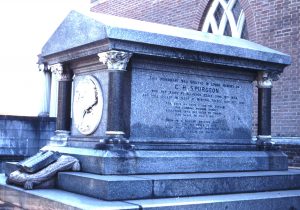
Tomb of Charles Spurgeon
Another grave - harder to find but worth the effort - is that of pioneer missionary Robert Moffat (1795-1883). It lies in square 56 (maps are available in the cemetery office), a few yards to the right of the main path. Covered with brambles when we called (removed by a helpful cemetery gardener), the horizontal stone commemorates Moffat and his wife Mary with the text Go ye into all the world and preach the gospel to every creature. The long-lived missionary survived both his son Robert, named on the upright stone and his more famous son-in-law, David Livingstone.

Robert Moffat's grave
Moffat, born in East Lothian, began his working life as a gardener. Called to missionary work through the Wesleyan Methodists, he arrived in Capetown in 1817. He made pioneer journeys across the Kalahari Desert to the Botswana tribes, and after many adventures settled in Kuruman, where he translated the New Testament into the Sechwana language. In 1819, he married Mary Smith, who shared his work for 50 years and his daughter Mary married David Livingstone in 1844. He returned to England in 1870, and in 1874 went to Southampton to receive Livingstone's body for burial in Westminster Abbey.
WIMBLEDON
From 1782 to 1787, the young MP William Wilberforce (1759-1833) lived at Lauriston House, on the south side of Wimbledon Common, originally the home of his uncle and aunt. Here, he would frequently entertain his friend William Pitt, Chancellor of the Exchequer at 23 and soon to be Prime Minister. At this stage in his life, Wilberforce was unmarried and had not yet taken up the cause that was to dominate his life, the abolition of the slave trade.
The site of Lauriston House, close to Rushmere Pond, is marked by a plaque on a house at the corner of Lauriston Road and Southside Common. The present house looks old enough to have been part of the original buildings, but other houses nearby are more recent. A crescent of modern houses in Lauriston Road is named Wilberforce Way.
ROTHERHITHE
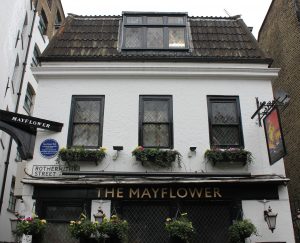
Mayflower Inn
Looking across from the south bank of the Thames to the iconic office blocks of the City, this was once a place of docks and shipping, involved especially with the Scandinavian timber trade, which explains the presence locally of Finnish and Norwegian churches.
Here too is the site from which the Brunels, father and son, began their project to build the world's first tunnel beneath a major river. Eventually completed in 1843, it is still used for trains today.
Rotherhithe was also the home of Christopher Jones (c1570- 1622), master of the Mayflower, used by him in the whaling industry and wine trade before its historic voyage in 1620, carrying 102 "planters and adventurers" to New England. Jones would have been a patron of the Shippe Inn, rebuilt as the Spread Eagle and Crown in about 1780 and renamed The Mayflower in 1957. The pub receives a steady stream of American visitors, including those claiming direct descent from the Pilgrim Fathers.
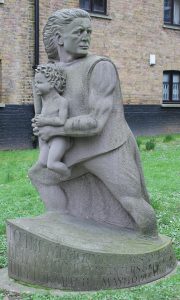
Christopher Jones memorial
Inside, the cramped space and dark wooden panelling give a good idea of the ambience of a 17th century inn, but the profusion of pictures, flags and ornaments filling every corner feels a little overdone. One interesting picture has dark silhouettes with the names of all the Mayflower passengers, while below the images are repeated, dark or shaded, to indicate those who survived to the first Thanksgiving in 1621 (perhaps about half) and those who did not. To gain a better sense of the voyage, head for the dining area extension and take your meal on the wooden jetty overhanging the river, where the river can be heard sloshing about, a fathom or so beneath your feet.
Nearby is the 18th century Church of St Mary the Virgin. You can enter the eastern part, and sign the visitors' book, but to the disappointment of many visitors, the main body of the church can only be viewed through glass windows, due to former theft and vandalism. Christopher Jones is buried here in an unmarked grave. A modern sculpture of St Christopher in the old burial ground commemorates his place in history.
GREENWICH
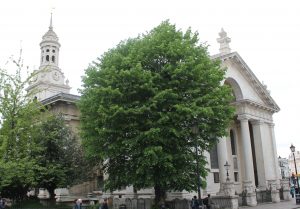
St Alfege's church, Greenwich
Most visitors to Greenwich will be heading for the National Maritime Museum, the former tea clipper Cutty Sark or the Royal Naval College, with its magnificent Painted Hall and Chapel. A few may notice the handsome Church of St Alfege (also spelt Alphege) in Greenwich High Road, built by Wren's disciple Nicholas Hawksmoor in the early eighteenth century.
The church has an impressive east front with Doric columns and is believed to stand on the site of the martyrdom of Alfege (953-1012). The gentle Saxon saint, renowned for his generosity to the poor, spent his early years as a monk in Gloucestershire. In 984, he was appointed Bishop of Winchester and was much involved in peacekeeping efforts with the Vikings, persuading the Norse king Olaf Tryggvesson to honour his former profession of Christianity.

Altar cloth, St Alfege's church
Appointed Archbishop of Canterbury in 1005, he was let down by the weakness of the Saxon king - Ethelred the Unready. It was the period of "Danegeld", when the Vikings were paid substantial sums to cease their raids, but declined to honour their pledges. In 1011, the Danes attacked Canterbury and captured Alphege. Hoping for a substantial ransom, they held him prisoner for seven months, but Alphege himself forbade the payment of any additional sums. On 19th April 1012, he was beaten to death with ox bones during a drunken feast.
Inside, Alfege is remembered by a stone slab set into the floor, and also by an embroidered altar cloth, showing him arriving at Greenwich by boat.


